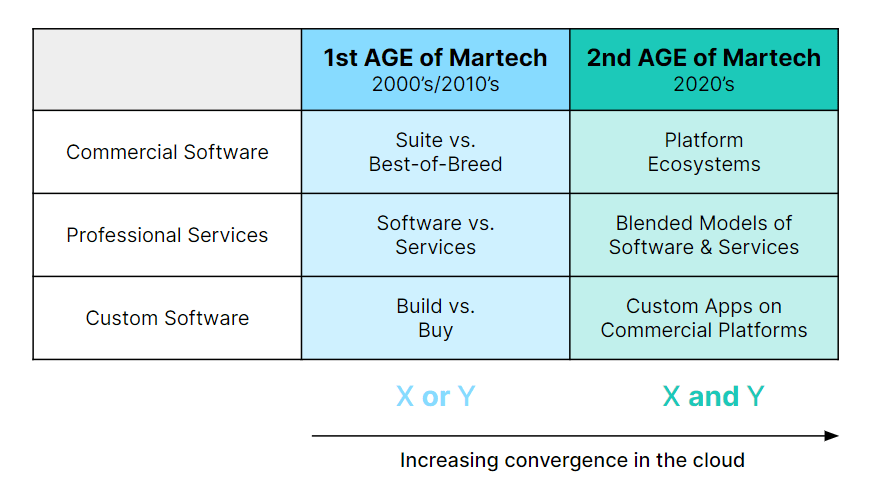BLOG | June 10, 2024
The Dawn of the Third Age in Martech: Operative and Financial Efficiency
In times of rapid changes, resources and budget must be used wisely. Properly investing in the right tools can help marketing teams do more with less.
The landscape of Marketing Technology (Martech) is entering a new phase in 2024: the age of operative and financial efficiency. This third age is marked by a paradigm shift where changes and impacts occur annually, or even more swiftly, challenging businesses to adapt quickly and optimize resources. This article explores the essence of this age, its operational dynamics, financial strategies, and the how to prepare for upcoming trends.
The Age of Martech has historically evolved in decade-long cycles, each characterized by substantial technological progress and shifts in marketing strategies. However, the dawn of the third age, which began in mid-2023 and is projected to extend into early 2025, heralds a significant divergence from this tradition: technology is changing faster and strategy changes require more precision. It is a deep examination of our Martech tools is needed to fully exploit their potential and identify synergistic opportunities across teams and outsourcing partners.
The firsts and second age of Martech
 https://chiefmartec.com/2022/08/the-2nd-age-of-martech-has-arrived-and-its-all-about-convergence-in-ecosystems/
https://chiefmartec.com/2022/08/the-2nd-age-of-martech-has-arrived-and-its-all-about-convergence-in-ecosystems/
Definition and characteristics of the last two ages:
From 1st to 2nd Age: From “or” to “both”
In 2019, Scott Brinker(1) , envisioned that we were on the brink of entering a Second Golden Age of Martech, characterized by::
- The debate of choosing between suite software solutions versus best-of-breed evolved into the building of an integrated platforms ecosystem.
- The choice between purchasing software or services merged into hybrid delivery models encompassing both.
- The decision of build-versus-buy transformed into purchasing commercial platforms and enhancing them with tailored customizations.
This shift meant moving away from the restrictive ‘either/or’ choices (which often led to suboptimal technological setups), towards a more inclusive ‘both/and’ perspective where complementary strengths were harnessed.
The integration of comprehensive marketing suites with open APIs and a vibrant marketplace for specialist apps exemplified this transformation. These integrations amplified best-of-breed solutions core capabilities, resulting in a more robust marketing suite. Software providers began offering specialized services to maximize product benefits, while service firms started implementing and customizing commercial software as part of their offers.. Customization has enabled businesses to create unique customer experiences and digital innovations without the need to start building systems from scratch. This new age fostered an environment where digital differentiation was achievable, without the need to overhaul legacy systems.
_____
(1) ChiefMartec Blog, by Scott Brinker’s, “The 2nd Age of Martech has arrived, and it’s all about convergence in ecosystems”
Why the 3rd Era is different
Context of the New Era:
 https://chiefmartec.com/2024/02/well-saas-tech-stacks-shrank-from-2023-to-2024-but-only-by-8-you-were-expecting-more/
https://chiefmartec.com/2024/02/well-saas-tech-stacks-shrank-from-2023-to-2024-but-only-by-8-you-were-expecting-more/
This age unfolds within a complex global context where companies are scrutinizing expenses, results, and return on investment (ROI) more closely than ever. This scrutiny demands every team to do more with less. To optimize resources, companies are prompted to conduct thorough evaluations of their Martech tools, seeking ways to amplify their efficiency.
To tackle the efficiency problem, companies are increasing collaboration between departments to create synergies and make the most out of their collective resources. They are also bringing external partners with specific expertise to improve operational standards.
Tool, licenses acquisition: impact on SaaS, some of them, Martech Stack
In 2023, the SaaS industry faced significant challenges, as companies aggressively seeked ways to cut costs eliminating non-essential app subscriptions. This led to an average 11% reduction in SaaS spending over the year.
Small and medium-sized businesses (SMBs) with up to 500 employees still manage on average 162 apps. Mid-market companies, with 501 to 2,500 employees, utilize around 245 apps. The martech stack size for small and medium companies has shrinked between 6% and 4% respectively in 2023..,
Albeitlbeit less drastic than some industry predictions suggested, there is a clear trend towards app consolidation. The sentiment that further consolidation is imminent persists, with some expecting a more dramatic shrinkage by year’s end.
Despite these cutbacks, the average Martech stack inside a company remains extensive.
However, my view is nuanced. On one hand, I do advocate for cost-effective stack management that maximizes return on investment (ROI), and I recognize the competitive dynamics that naturally lead to a few market leaders emerging.
On the other side, companies are still pursuing new technologies, specially with the rapid integration of AI-powered solutions, Yet, the broader picture reveals a period of relentless technological advancement, particularly with the rapid integration of AI technologies, fostering a fertile ground for startup innovation and necessitating continuous adoption of new technologies by companies to stay competitive.
This is evident in the consistent influx of new SaaS applications into companies’ Martech stacks, reflecting the dynamic and evolving nature of the industry.
Defining Characteristics of the New Age
Summarizing what has been discussed so far, and as you might have noticed through this reading or are likely experiencing in your company, this new age does not bring about the significant technological leaps seen in previous phases, although artificial intelligence (AI) plays a crucial role, as it does across industries and in the SaaS sector.
This age is primarily driven by operational and financial efficiency, focusing on doing more with the same resources, maximizing their use, and addressing only those gaps that are game-changers for growth. These gaps can be filled either by incorporating new tools or by optimizing existing ones, leveraging connectors, and so forth.
The lack of massive technological shifts, while financially oriented, does not make this age dull. In fact, there is a significant change in the speed and duration this era is expected to have.
The key here is not to be overwhelmed or overtaken by this third age, nor to watch it pass by as if it were something normal. Instead, it should be seen as an opportunity to grow, evolve, gain depth and knowledge, enhance creativity, and move from hiring just because it’s possible to hiring based on a worthwhile use case. It’s a time to look beyond what we lack and think about what we have and how we can enhance it.
- Accelerated Transformation: In the current age, the Martech landscape is undergoing rapid evolution, with swift and continuous transitions that necessitate agile adaptation from businesses to retain their market relevance and competitive advantage. This dynamic not only affects the creators of Martech and data products but also the companies that utilize these solutions. Both face the challenge of navigating this fast-paced environment, where staying ahead requires a proactive and responsive strategy.
- Enhanced Operational Efficiency: The focus is increasingly on leveraging existing resources more effectively, streamlining operations, and boosting the capabilities of the current Martech stack. This shift aims to foster more sustainable and efficient practices, ensuring that businesses can achieve more with less and improve overall performance. The drive for operational efficiency extends across the board, compelling companies to refine their processes and extract maximum value from their technological investments.
- Stringent Financial Management: This age demands rigorous financial management, emphasizing the need to maximize the return on investment (ROI) for every component of the Martech stack. Businesses are now expected to engage in real-time budget tracking and strategic financial planning. This heightened financial scrutiny brings new stakeholders into the fold, particularly CFOs, who require a deeper understanding of the tools’ utility, cost, and return. The challenge lies in educating these traditionally less involved figures, making them integral to the ongoing Martech strategy and decision-making process.
- Collaborative IT Leadership: While IT departments continue to spearhead strategy and implementation, there is a growing trend toward partnering with specialized outsourced teams that possess advanced Martech expertise. This collaboration not only accelerates the pace of innovation and execution but also elevates the internal team’s capabilities by introducing new skills and perspectives. The integration of outsourced expertise with in-house IT strategy creates a powerful synergy, enhancing the Martech stack’s performance and driving the company’s growth in this rapidly evolving digital age. More info in the next content block about roles moving on this age.
Role moving on this new Age
This transition also marks a pivotal shift from the previous age in terms of the roles and team making things happen, where IT teams predominantly managed the Martech stack. In this new age, despite the increasingly complex and demanding product backlog — encompassing new features, experimentation, and maintenance — the responsibility continues to rest with IT teams. However, the strategy is evolving. The complexity and pace of growth in the backlog demand that IT not only maintain control but also seek specialized outsourcing partnerships. This approach enables the tackling of the backlog with greater efficiency and expertise, thereby accelerating company growth.
The strategic emphasis is on balancing the intricate product backlog with the proactive engagement of specialized IT outsourcing teams as an strategic and implementation partner. This balance is crucial for managing the growing complexities and expectations within the Martech landscape efficiently. Such collaboration not only brings in external expertise but also alleviates the pressure on in-house IT teams, allowing for a more focused and accelerated growth impact for the company, and let’s be honest, it’s creating relief in a tense relationship between marketing/growth and IT teams.
This evolution signifies a crucial shift, highlighting the growing importance of growth and marketing teams in defining use cases and their potential impact. While IT departments have traditionally managed the Martech stack, the new age underscores the need for growth and marketing teams to take the lead in crafting detailed use cases and outlining the business impact, independent of specific tools. The actual selection and implementation of tools to execute these use cases fall within IT’s purview (in collaboration with an outsourcing specialized team), embodying a collaborative approach where growth initiates the strategic vision and IT operationalizes it with tech strategic view. This partnership ensures that decisions are driven by strategic needs rather than technological capabilities.
And the data team is not invited to the party? Or is it just about growth and IT dancing with tools?
Thinking in terms of technology or tools first is akin to planning the execution before clarifying the objective. It’s essential that the process begins with a clear understanding of what needs to be achieved, allowing the technology to serve the strategy rather than dictate it.
In this synergistic relationship between IT, growth, and marketing, data teams play a pivotal role. They manage the company’s most crucial asset—data. The synergy between IT and growth/marketing teams must extend to include data teams, who are responsible for developing, enriching, ingesting, testing, and experimenting with data (for example data models) to drive evolution and enhance effectiveness. Activating data is the key enabler of growth operations, making it imperative for data teams to be integrally involved in this dynamic interplay, ensuring that data-driven insights are at the heart of growth strategies and operations.
Main takeaways of this new Age
- Strategic Adaptations:
- In this new age, companies are moving towards a more disciplined and selective approach to Martech investments, prioritizing tools and strategies that fill actual gaps and offer tangible benefits.
- Outsourcing becomes a strategic lever, enabling companies to access specialized skills and accelerate the adoption of efficient practices in Martech and data management.
- Challenges and Opportunities:
- The primary challenge in this era is managing the balance between adopting innovative technologies and maintaining financial health. Companies must navigate these waters with a strategic mindset, focusing on investments that offer real value.
- The opportunity lies in leveraging this period of rapid change to reassess and realign Martech strategies with broader business objectives, ensuring a cohesive and efficient approach.
Conclusion
Thus, the third age of Martech represents a period of strategic recalibration and intensified efficiency, driven by the imperative to swiftly adapt to the dynamic digital and global business milieu. By optimizing existing tools, enhancing team collaboration, and judiciously integrating external expertise, companies can successfully navigate this Age. This strategic approach lays a robust foundation for sustained growth and innovation in the Martech sector, signaling a mature response to the evolving challenges and opportunities.
The accelerated arrival of the new age in Martech signifies a pivotal shift towards operative and financial efficiency. Businesses are now challenged to adapt rapidly, making strategic decisions that align with this fast-paced era. By embracing these changes and focusing on strategic resource optimization, companies can achieve sustainable growth and remain competitive in the ever-evolving Martech landscape.
Looking Ahead
Discussing the next age and based on historical data of global economic behavior and cycles and business cycles, along with the lessons learned from the age we are currently navigating (hopefully, we can record, capitalize on, and not forget them, we will pass this age with interesting learnings…), I dare to suggest that the upcoming Martech Age will be characterized by:
- Shorter cycles of 1 or 2 years, no longer.
- Continued operational and financial efficiency mindset, a legacy of the current age.
- The Martech tool ecosystem will be impacted by these changes, likely leading to a streamlined landscape.
- The integration of AI into the Martech tool ecosystem, as well as its broader use within companies, will have a significant impact. This will be an age where we may focus more on how AI can solve issues rather than how a specific Martech stack tool can (his rapid transformation is due to the swift and significant rise of AI in recent months).
- Outsourcing within IT teams will become a key and consolidated element to alleviate the operational and financial pressures of the current stack, assist in building strategies, map out the new stack, and implement it swiftly. Furthermore, it will play a crucial role in discovering how to integrate AI within companies.
- Feedback from these specialized IT outsourcing teams for the Martech backlog will be vital. Tools within the landscape must maximize this insight, as these teams will be directly addressing client pain points.
The coming years will be exciting for everyone involved in Growth transformation! The anticipated Martech age suggests a shift towards more dynamic, efficient, and AI-driven approaches, facilitating rapid adaptation and streamlined operations. This new phase will challenge us to rethink our strategies and leverage AI and outsourcing to enhance our growth and operational capabilities in the ever-evolving digital landscape.

Jota Juárez
Tech & Data Studio Lead, Winclap
Growth Tech Enthusiast and maker
Need help to build your Martech Stack strategy and implementation?
Contact us and let’s make a free 60 minutes all assessment with our Tech & Data team Experts.
